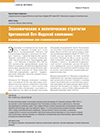Economic and Political Strategy of the British East India Company: Complementarity or Mutual exclusion?
DOI: 10.33917/es-4.162.2019.92-99
The article deals with correlation between the trade and the power nature of the East India Company (1600–1874) as a key agent of the British Empire in Asia. The main stages of its activity are traced, transformation of its strategies and goals is explained. If in the first century and a half economic and political strategies of the company complemented each other with priority of the first, then with the company’s institutional mutation in the middle of the XVIII century there emerged tension between strategies arose. The company’s coming to power in Bengal, establishment of state control over the company and the British industrial revolution not only brought the company’s political strategies to the forefront, but replaced its economic goals with political ones, transforming the company into an instrument of governing India
References:
|
1. Oltarzhevskii V.P., Beidina T.E., Voronkova G.V. Angliiskaya Ost-Indskaya Kompaniya v XVII veke [English East India Company in the XVII century]. Irkutsk: Izd-vo Irkut. un-ta, 1988, p. 14. 2. Marshall P.J. East Indian Fortunes: The British in Bengal in the Eighteenth Century. Oxford: Clarendon Press, 1976, p. 57. 3. Ghulam H.S. The Riyazu-s-Salatin. Calcutta: Asiatic Society of Bengal, 1898, p. 33. 4. Braudel F. Civilisation matйrielle, йconomie et capitalisme, XVe — XVIIIe siиcle. 3 t. P.: Armand Colin, 1979, t. III. Le temps du monde, p. 621 5. Auber P. Rise and Progress of the British Power in India. 2 vols. L.: W.H. Allen, 1837. Vol. I. P. 621. P. 44. 6. Bayly C.A. Indian Society and the Making of the British Empire. The New Cambridge History of India, vol. II.1. Cambridge: Cambridge University Press, 1988, p. 46. 7. A Collection of Treaties and Engagements with the Native Princes and States of Asia Concluded, on Behalf of the East India Company, by the British Governments in India; also Copies of Sunnuds, or Grants, of Certain Privileges and Immunities to the East India Company by the Mogul, and Other Native Princes of Hindustan. L.: Cox and Son, 1812, p. 39–42. 8. Indian Constitutional Documents 1757–1939. Ed. by A.C. Banerjee. 3 vols. Calcutta: A. Mukherjee, 1948, vol. I. 1757–1858, p. 10–12. 9. Bowen H.V. The Business of Empire: The East India Company and Imperial Britain, 1756–1833. Cambridge etc.: Cambridge University Press, 2006, p. 224. 10. Robins N. The Corporation That Changed the World: How the East India Company Shaped the Modern Multinational. Hyderabad: Orient Longman, 2006, p. 147. 11. Bayly C.A. Imperial Meridian: The British Empire and the World, 1780–1830. L.; N.Y.: Longman, 1989, p. 106. 12. Wilbur M.E. The East India Company and the British Empire in the Far East. N.Y.: Richard R. Smith, 1945, p. 366. 13. Nightingale P. Trade and Empire in Western India, 1784–1806. Cambridge: Cambridge University Press, 1970, p. 184. 14. Erikson E. Between Monopoly and Free Trade: The English East India Company, 1600–1757. Princeton (N.J.); Oxford: Princeton University Press, 2014, p. 178. 15. Arrighi G. The Long Twentieth Century: Money, Power, and the Origins of Our Times. L.; N.Y.: Verso, 1994, p. 127–158. |



